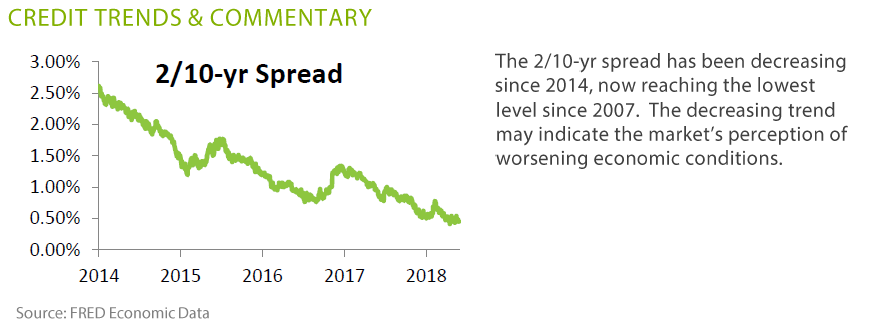
Credit Quarterly Recent News
Impact of Tax Cuts on Bank Profitability
On December 20, 2017, Congress passed the Tax Cuts and Jobs Act designed to cut taxes on individuals and corporations. The Act reduced the corporate income tax from 35% to 21% effective January 1, 2018. As a result, the average effective tax rate for financial institutions for the first quarter of 2018 was 21% compared to 30% in the first quarter of 2017. The lower corporate tax rate helped boost net income at FDIC-covered institutions by roughly 27.5% in the first quarter of 2018 compared to the same period last year. Without the tax changes, net income would have been 12% lower than reported in first quarter 2018. Approximately 75% of banks saw quarter-over-quarter growth in earnings. In addition to tax cuts, an 8.5% increase in net interest income in the first quarter of 2018, compared to first quarter of 2017, aided bank earnings. Community banks, banks with less than $50 billion in total assets, saw an increase in net income of 25% in the first quarter compared to the same period last year. Large banks, banks with more than $250 billion in total assets, also saw an increase of 25% in their net income compared to the previous year. Regional banks, banks with assets between $50 billion and $250 billion, saw the largest growth with a 43% increase in net income compared to the same period last year.

Credit Quarterly Banking Trends
FDIC-insured institutions reported net income of $65.0 billion, an increase of $12.1 billion (27.5%) compared with the prior year period. The increase was mainly driven by lower income taxes enacted from the new tax law, offset in part by higher loan loss provisions and noninterest expense. Excluding the tax effects, estimated quarterly net income would have been $49.4 billion, an increase of 12.6% from a year ago. More than 85% of banks reported year-over-year increases in net interest income(NIM). Average NIM increased to 3.32% from 3.19% in first quarter of 2017. less than 4% of institutions were unprofitable during the quarter, the lowest level since the first quarter of 1996.
Provisions for loan losses in the fourth quarter totaled $12.4 billion, an increase of $35.6 million from a year ago. More than a third of institutions reported higher loan-loss provisions than in first quarter 2017. Noncurrent balances for total loans and leases decreased $3.9 billion(3.4%) during the first quarter compared to the prior year first quarter. Average net charge-off rate remained stable at 0.50%.
Total assets grew slightly by $116.1 billion (0.3%) from the previous quarter. Balances in all major loan categories except card balances and home equity loans experienced growth. Total equity capital increased by $11.2 billion from the previous quarter. Retained earnings contributed $25.3 billion to equity growth. Declared dividends in the first quarter totaled $30.7 billion, an increase of 12.2% from the same period last year. The number of institutions on the FDIC’s “Problem List” declined from 95 to 92 in the first quarter, the lowest number of problem banks since first quarter 2008. During the quarter, three new charters were added, 65 institutions were absorbed by mergers, and zero institutions failed.
Source: FDIC: Quarterly Banking Profile
Prudent Man Process
The Prudent Man Analysis
The Prudent Man Process includes four steps which begin with gathering data and analyzing a bank’s credit quality and continues with ongoing risk management throughout the life of a deposit. The process helps public funds investors avoid repayment, reinvestment and reputation risk that may be associated with a bank failure.
Step 2: Data Analysis – Qualitative
PMA conducts quantitative ratio analysis utilizing a proprietary model to analyze bank and holding company data. Ratios are compared to historical trends, bank peers, and performance benchmarks. PMA begins its quantitative analysis of a bank’s regulatory capital, asset quality and earnings by analyzing the following ratios:
-
- Total Risk Based Capital
-
- Nonperforming Assests
-
- Return on Average Assets
-
- Net Interest Margin
Additionally, PMA prepares a credit report for each bank that analyzes financial performance over a 5 year period. The analysis covers more than 50 ratios and delves further into a bank’s balance sheet, income statement and off-balance sheet exposure.